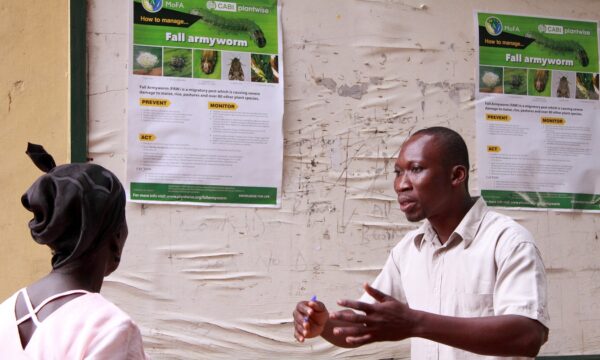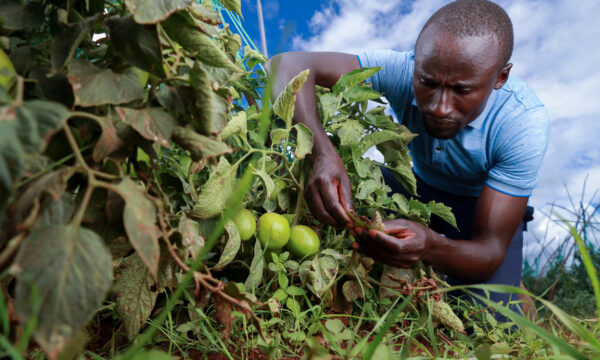 The Fall armyworm, Spodoptera frugiperda, is a major invasive pest in Africa. It has a voracious appetite and feeds on more than 80 plant species, including maize, rice, sorghum and sugarcane. Another feature which makes it an incredibly successful invasive species is its ability to spread and reproduce quickly. CABI have developed a poster to show the life cycle of the Fall armyworm, which includes egg, 6 growth stages of caterpillar development (instars), pupa and adult moth. Click here to view the full poster, or read about the life cycle below.
The Fall armyworm, Spodoptera frugiperda, is a major invasive pest in Africa. It has a voracious appetite and feeds on more than 80 plant species, including maize, rice, sorghum and sugarcane. Another feature which makes it an incredibly successful invasive species is its ability to spread and reproduce quickly. CABI have developed a poster to show the life cycle of the Fall armyworm, which includes egg, 6 growth stages of caterpillar development (instars), pupa and adult moth. Click here to view the full poster, or read about the life cycle below.
Day 1-3
100-200 eggs are generally laid on the underside of the leaves typically near the base of the plant, close to the junction of the leaf and the stem. These are covered in protective scales rubbed off from the moths abdomen after laying. When populations are high, the eggs may be laid higher up the plants or on nearby vegetation.
Day 3-6
Growth stages 1-3: After hatching, the young caterpillars feed superficially, usually on the undersides of leaves. Feeding results in semitransparent patches, or “windows”, on the leaves. Young caterpillars can spin silken threads which catch the wind and transport the caterpillars to a new plant. The leaf whorl is preferred in young plants, whereas the leaves around the cob silks are attractive in older plants. If the plant has already developed cobs then the caterpillar will eat its way through the protective leaf bracts into the side of the cob where it begins to feed on the developing kernels. Feeding is more active during the night.
Day 6-14
Growth stages 4-6: By stages 4-6, the fall armyworm will have reached the protective region of the whorl, where it does the most damage, resulting in ragged holes in the leaves. Feeding on young plants can kill the growing point, resulting in no new leaves or cobs. Often only 1 or 2 caterpillars found in each whorl, as they become cannibalistic when larger and will eat each other to reduce competition for food. Large quantities of frass (caterpillar poo) , which resembles sawdust, will be present.
Day 14-23
After approximately 14 days the fully grown caterpillar will drop to the ground. The caterpillar will then burrow 2-8 cm into the soil before pupating. The loose silk oval shape cocoon is 20-30 mm in length. If the soil is too hard then the caterpillar will cover itself in leaf debris before pupating. After approximately 8-9 days the adult moth emerges to restart the cycle.
This information is also available as a video:
This information has been adapted from ‘Fall Armyworm: Life cycle and damage to Maize’
To read more about what CABI is doing to help control Fall Armyworm in sub-Saharan Africa, please visit www.cabi.org/fallarmyworm
11 Comments
Leave a Reply
Related News & Blogs
How do pest risk registers address the spread of plant pests in Africa?
Pest risk registers can help to solve problems in agriculture, addressing the growing global threat of plant pests. Moreover, changing weather patterns, led by rising temperatures, are causing them to reproduce faster and expand into new regions. In ad…
10 July 2025





Reblogged this on The Invasives Blog.
[…] The Life Cycle of Fall Armyworm […]
It’s terribly, but we’re now facing attack from these worms in our corn fields here in Jitumu, southerne Bamako. Many fields starts being affectd but no one seems to be taking the threat it poses seriously . But the question we have now is related to the remedies already existing against these famous worms? Thanks
You’ll find information about the control of fall armyworm on the Plantwise knowledge bank – http://www.plantwise.org/fallarmyworm.
Some materials that might be of particular relevance are:
– FAW Pest Management Decision Guide (written in Ghana): http://www.plantwise.org/FullTextPDF/2017/20177800275.pdf
– Managing FAW (Poster): http://www.plantwise.org/FullTextPDF/2017/20177800660.pdf
We already downloaded plenty of stuff from that bank we’re now sharing with peasants out here.Thank you Claire for the advice! We will go back there and try to find new facts about that famous worm. Bilaly Konaté
Hi Claire,
None of these links seem to be available. Is there a problem with the server? We are supporting CABI’s Plant Clinics in several countries.
thanks,
Paul, SHA
Please control of fall army worm maize crop pesticide products? In pakistan best results? Any company
reaaly the fall army worm is athreat to the community
I have found this page to be very helpful because for us here in Uganda army worm has become a serious cause of concern as our farmers have lost a lot especially maize farmers. I will share the information I have got here and we practice it to see how effective it is.
[…] The Life Cycle of Fall Armyworm (2017) […]
[…] The Life Cycle of Fall Armyworm […]